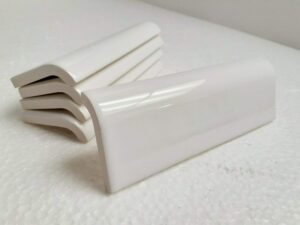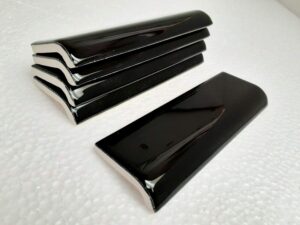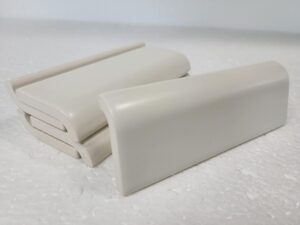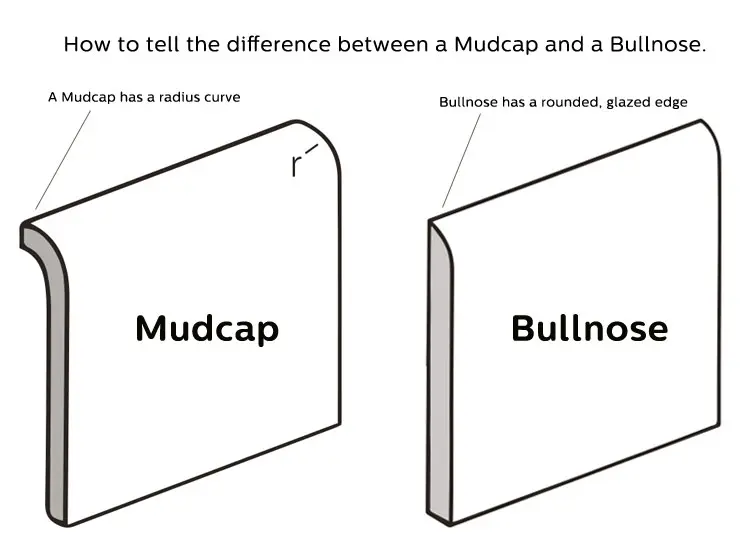Table of Contents
ToggleTiles are not only used in bathrooms or kitchens. They are adaptable and universal. Numerous types and designs of tiles come in various materials. These tiles have various patterns that give the floor a lively appearance and a touch of elegance. Additionally, these floor tiles provide a smooth walking surface and facilitate easier floor cleaning. However, tiles are not just for floors; they can also be used on walls. Many different wall tiles are available, and they unquestionably enhance the beauty of the space. Numerous varieties of tiles exist, as we have already discussed.
Bull nose and mud cap tile are two distinct tile types with different purposes. They do differ in shape, and their construction has a purpose. Determine which is the best choice to take into consideration by learning more about the similarities and differences between mud cap tile and bull nose.
Description of Mud Cap Tile
The edge of a mud cap tile is curved inward. These tiles are used to create the transition between the floor and the wall. The sharp edge that usually appears after installing tiles needs to be rounded to prevent unintentional injuries. Although these mud cap tiles already have one curved edge, inserting them in the space between the wall and the floor would give them a smoother appearance and edge. Cove tiles are another name for these tiles. They have a J hook radius, so applying it results in a finished, smoother edge. Additionally useful, these mud cap tiles can be used in showers and swimming pools.
It Is suitable for areas with high temperatures and is frost resistant. Mud cap tike comes in two different varieties, including stack-on cove bases for walls and sanitary cove bases for floors.
Let us take a quick look at some of the top mud cap tiles for your house.
We Recommend the Following Products:
1. Bright White Arctic 2x6 in Ceramic Tile Mud Cap Bullnose

This tile has a mud cap and is bright white. There are two sizes available. This mud cap tile comes in a polished finish. There are 5 of them in the box. They have quality, and their shine will not let you down.
2. Black 2 x 6 in Ceramic Tile Bullnose Mud Cap

This tile has a curved edge and is black. Since they are available in black, you can coordinate them with the black tiles on your wall or floor. It also has a nice shine and will undoubtedly produce a polished appearance. They come in 5 pieces per box.
3. Biscuit Bone Ceramic Tile Mudcap Bullnose Mud Cap

This is a beige mud cap tile as well. For an elegant appearance, you can easily place them over your backsplash. They have a 6-inch diameter. Additionally, a pack of them contains 5 pieces.
Bullnose
Bullnose tile is easily recognized because of its rounded edges. Corners are frequently covered with bullnose tiles. Additionally, they are utilized to enclose the edge of a tile design. As a result, there won’t be any sharp edges on the wall or floor. Numerous tile designs on the market go well with Bullnose tiles.
Bullnose Tile Types
Bullnose tiles come in several varieties, each with a different set of applications. Here are some of them:
Square Bullnose Tiles
This kind of tile is commonplace. This trim is the most popular. Choose these if you’re looking for Bullnose tiles to put on a backsplash or countertops. They are long enough that you won’t need as many of them.
Bullnose Square Tiles
Another variety of Bullnose tile is this. If you want a tile that has a checkered appearance, choose this type. They complement finer tile arrangements well.
Bullnose Tile Corner
This kind of tile has two rounded edges that are visible. These tiles are designed to go in a frame’s corners. Its additional edges give the frame a nice, polished appearance. It is frequently applied to any wall or backsplash to enhance the features.
Uses of Bullnose Tiles
We are familiar with many details about Bullnose tiles, including their appearance, types, and uses. But now is the time to learn more about their precise uses. Here are some of them:
Usually, when you install tiles on a wall, a line will appear along the wall, giving the wall an unfinished appearance. But these tiles will make sure to give a finished look, increasing the elegance of your wall in the process.
Corners
To create a tidy appearance, these Bullnose tiles are also used around corners. They can be used in the corner of the bathtub, a countertop, or other appropriate niches. These tiles’ rounded edges will undoubtedly make you safer.
Floors
To provide a final appearance at the side where the floor and wall converge. They complement any style of design well. Additionally, they shield the floor and wall from water leaks.
Decoration
It can also make the surface more beautiful. It gives the surface where it is placed an extra touch of elegance. These tiles are ideal if you want a traditional accent wall.

